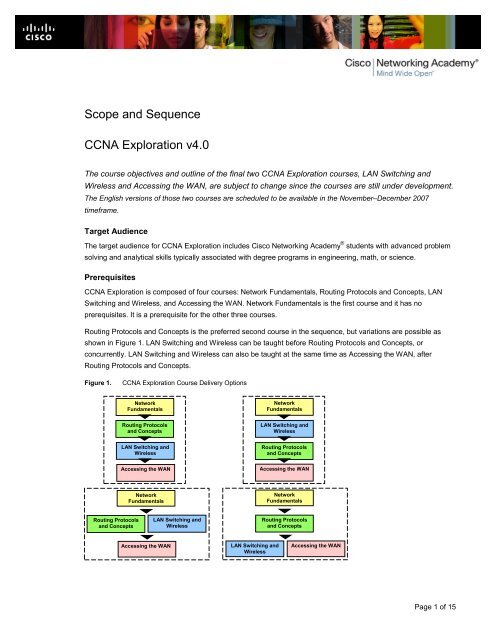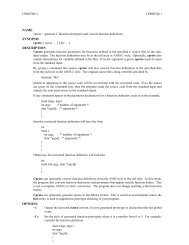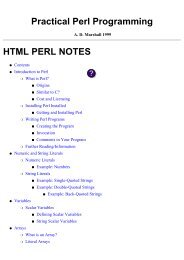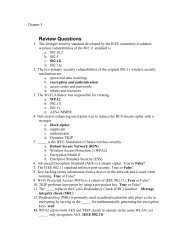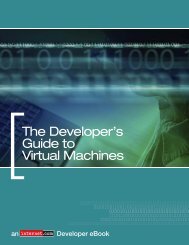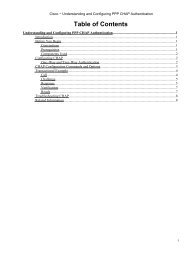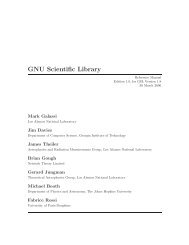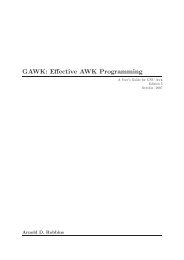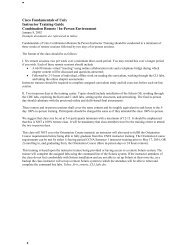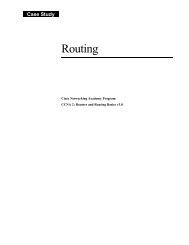Scope and Sequence CCNA Exploration v4.0 - Cisco Academy
Scope and Sequence CCNA Exploration v4.0 - Cisco Academy
Scope and Sequence CCNA Exploration v4.0 - Cisco Academy
Create successful ePaper yourself
Turn your PDF publications into a flip-book with our unique Google optimized e-Paper software.
<strong>Scope</strong> <strong>and</strong> <strong>Sequence</strong><strong>CCNA</strong> <strong>Exploration</strong> <strong>v4.0</strong>The course objectives <strong>and</strong> outline of the final two <strong>CCNA</strong> <strong>Exploration</strong> courses, LAN Switching <strong>and</strong>Wireless <strong>and</strong> Accessing the WAN, are subject to change since the courses are still under development.The English versions of those two courses are scheduled to be available in the November–December 2007timeframe.Target AudienceThe target audience for <strong>CCNA</strong> <strong>Exploration</strong> includes <strong>Cisco</strong> Networking <strong>Academy</strong> ® students with advanced problemsolving <strong>and</strong> analytical skills typically associated with degree programs in engineering, math, or science.Prerequisites<strong>CCNA</strong> <strong>Exploration</strong> is composed of four courses: Network Fundamentals, Routing Protocols <strong>and</strong> Concepts, LANSwitching <strong>and</strong> Wireless, <strong>and</strong> Accessing the WAN. Network Fundamentals is the first course <strong>and</strong> it has noprerequisites. It is a prerequisite for the other three courses.Routing Protocols <strong>and</strong> Concepts is the preferred second course in the sequence, but variations are possible asshown in Figure 1. LAN Switching <strong>and</strong> Wireless can be taught before Routing Protocols <strong>and</strong> Concepts, orconcurrently. LAN Switching <strong>and</strong> Wireless can also be taught at the same time as Accessing the WAN, afterRouting Protocols <strong>and</strong> Concepts.Figure 1.<strong>CCNA</strong> <strong>Exploration</strong> Course Delivery OptionsNetworkFundamentalsNetworkFundamentalsRouting Protocols<strong>and</strong> ConceptsLAN Switching <strong>and</strong>WirelessLAN Switching <strong>and</strong>WirelessAccessing the WANRouting Protocols<strong>and</strong> ConceptsAccessing the WANNetworkFundamentalsNetworkFundamentalsRouting Protocols<strong>and</strong> ConceptsLAN Switching <strong>and</strong>WirelessRouting Protocols<strong>and</strong> ConceptsAccessing the WANLAN Switching <strong>and</strong>WirelessAccessing the WANPage 1 of 15
Target CertificationsAfter completing <strong>CCNA</strong> <strong>Exploration</strong>, students will be prepared to take the <strong>CCNA</strong> Certification Exam.Curriculum DescriptionThis curriculum presents a comprehensive overview of networking; from fundamentals to advanced applications<strong>and</strong> services. It is based on the top-down approach to networking that is popular in many colleges <strong>and</strong> universities.The course emphasizes concepts <strong>and</strong> skills required to design networks, while providing opportunities for practicalapplication <strong>and</strong> h<strong>and</strong>s-on experience by teaching students how to install, operate, <strong>and</strong> maintain networks.Some of the main features of <strong>CCNA</strong> <strong>Exploration</strong> are as follows:● Can be part of an integrated curriculum or continuing education program at postsecondary institutions suchas career <strong>and</strong> technical schools, colleges, <strong>and</strong> universities● Allows students to learn skills in a more comprehensive, theoretical, <strong>and</strong> practical way that is reflective ofcommon educational practices at the college level; <strong>and</strong> uses language that integrates related engineeringconcepts● Presents comprehensive coverage of networking topics, ranging from fundamentals to advancedapplications <strong>and</strong> services● Includes highly-complex <strong>and</strong> challenging h<strong>and</strong>s-on labs● Offers more flexibility in the curriculum delivery <strong>and</strong> permits shortened course delivery time● Helps prepare students for continuing education <strong>and</strong> professional careers in ITCurriculum ObjectivesThis curriculum provides students with the skills needed to succeed in networking-related degree programs <strong>and</strong>helps them prepare for <strong>CCNA</strong> certification. It also helps students develop the skills necessary to fulfill the jobresponsibilities of network technicians, network administrators, <strong>and</strong> network engineers. It provides a theoreticallyrich,h<strong>and</strong>s-on introduction to networking <strong>and</strong> the Internet.Upon completion of the Network Fundamentals course, students will be able to perform the following tasks:● Explain the importance of data networks <strong>and</strong> the Internet in supporting business communications <strong>and</strong>everyday activities● Explain how communication works in data networks <strong>and</strong> the Internet● Recognize the devices <strong>and</strong> services that are used to support communications across an Internetwork● Use network protocol models to explain the layers of communications in data networks● Explain the role of protocols in data networks● Describe the importance of addressing <strong>and</strong> naming schemes at various layers of data networks● Describe the protocols <strong>and</strong> services provided by the Application layer in the OSI <strong>and</strong> TCP/IP models <strong>and</strong>describe how this layer operates in various networks● Analyze the operations <strong>and</strong> features of the Transport layer protocols <strong>and</strong> services● Analyze the operations <strong>and</strong> feature of the Network layer protocols <strong>and</strong> services <strong>and</strong> explain the fundamentalconcepts of routingPage 2 of 15
● Describe the basis features <strong>and</strong> concepts of link-state routing protocols● Describe the purpose, nature, <strong>and</strong> operations of the Open Shortest Path First (OSPF) Protocol● Configure <strong>and</strong> verify basic RIPv1, RIPv2, single area OSPF, <strong>and</strong> EIGRP operations in a small routednetwork.● Use router show <strong>and</strong> debug comm<strong>and</strong>s to troubleshoot common errors that occur in small routed networks.Upon completion of the LAN Switching <strong>and</strong> Wireless course, students will be able to perform the followingfunctions:• Identify <strong>and</strong> correct common network problems at layers 1,2,3 <strong>and</strong> 7 using a layered model approach• Interpret network diagrams• Select the appropriate media, cables, ports, <strong>and</strong> connectors to connect switches to other network devices<strong>and</strong> hosts.• Explain the technology <strong>and</strong> media access control method for Ethernet networks.• Explain basic switching concepts <strong>and</strong> the operation of <strong>Cisco</strong> switches.• Perform <strong>and</strong> verify initial switch configuration tasks including remote access management.• Describe enhanced switching technologies (VTP, RSTP, VLAN, PVSTP, 802.1q)• Describe how VLANs create logically separate networks <strong>and</strong> the need for routing between them.• Configure, verify, <strong>and</strong> troubleshoot VLANs• Configure, verify, <strong>and</strong> troubleshoot trunking on <strong>Cisco</strong> switches• Configure, verify, <strong>and</strong> troubleshoot interVLAN routing• Configure, verify, <strong>and</strong> troubleshoot VTP• Configure, verify, <strong>and</strong> troubleshoot RSTP operation• Interpret the output of various show <strong>and</strong> debug comm<strong>and</strong>s to verify the operational status of a <strong>Cisco</strong>switched network.• Verify network status <strong>and</strong> switch operation using basic utilities (ping, traceroute, telnet, SSH, arp,ipconfig), SHOW & DEBUG comm<strong>and</strong>s.• Identify, prescribe, <strong>and</strong> resolve common switched network media issues, configuration issues,autonegotiation, <strong>and</strong> switch hardware failures• Manage <strong>Cisco</strong> IOS.• Manage IOS configuration files. (save, edit, upgrade, restore)• Describe st<strong>and</strong>ards associated with wireless media (IEEE WI-FI Alliance, ITU/FCC)• Identify <strong>and</strong> describe the purpose of the components in a small wireless network. (SSID, BSS, ESS)Page 4 of 15
• Identify the basic parameters to configure on a wireless network to ensure that devices connect to thecorrect access point.• Compare <strong>and</strong> contrast wireless security features <strong>and</strong> capabilities of WPA security(open, WEP, WPA-1/2)• Identify common issues with implementing wireless networks. (Interference, Misconfiguration)Upon completion of the Accessing the WAN course, students will be able to perform the following functions:• Describe the impact of applications (Voice Over IP <strong>and</strong> Video Over IP) on a network• Identify <strong>and</strong> correct common network problems at layers 1,2,3 <strong>and</strong> 7 using a layered model approach• Interpret network diagrams• Describe the components required for network <strong>and</strong> Internet communications .• Implement basic switch security (port security, trunk access, management vlan other than vlan1,etc.)• Explain the operation <strong>and</strong> benefits of using DHCP <strong>and</strong> DNS.• Configure, verify <strong>and</strong> troubleshoot DHCP <strong>and</strong> DNS operation on a router.(CLI/SDM)• Describe today’s increasing network security threats <strong>and</strong> explain the need to implement a comprehensivesecurity policy to mitigate the threats• Explain general methods to mitigate common security threats to network devices, hosts, <strong>and</strong> applications.• Describe the functions of common security appliances <strong>and</strong> applications• Describe security recommended practices including initial steps to secure network devices• Describe the purpose <strong>and</strong> types of ACLs.• Configure <strong>and</strong> apply ACLs based on network filtering requirements.(CLI/SDM)• Configure <strong>and</strong> apply an ACLs to limit telnet <strong>and</strong> SSH access to the router using (SDM/CLI)• Verify <strong>and</strong> monitor ACLs in a network environment.• Troubleshoot ACL issues.• Explain the basic operation of NAT.• Configure NAT for given network requirements using (CLI/SDM)• Troubleshoot NAT issues• Describe different methods for connecting to a WAN• Configure <strong>and</strong> verify a basic WAN serial connection.• Configure <strong>and</strong> verify a PPP connection between <strong>Cisco</strong> routers• Configure <strong>and</strong> verify Frame Relay on <strong>Cisco</strong> routers• Troubleshoot WAN implementation issues.Page 5 of 15
• Describe VPN technology (importance, benefits, role, impact, components)Minimum System RequirementsCurriculum requirements:● 1 Student PC per student; 1 local curriculum serverLab bundle requirements:● 3 <strong>Cisco</strong> 1841 routers with Base IP IOS, 128 MB DRAM, 32 MB Flash● 3 2960 switches,● 2 Linksys wireless routers (Linksys 300N is preferred; 54G is an alternative) or SOHO equivalent● 1 Lab PC with Microsoft Windows 2000 Server● 3 Lab PCs or laptops (Microsoft Windows 2000 or Windows XP)● Assorted Ethernet <strong>and</strong> Serial cables <strong>and</strong> hubsCourse OutlineNetwork FundamentalsThis course introduces the architecture, structure, functions, components, <strong>and</strong> models of the Internet <strong>and</strong> othercomputer networks. It uses the OSI <strong>and</strong> TCP layered models to examine the nature <strong>and</strong> roles of protocols <strong>and</strong>services at the application, network, data link, <strong>and</strong> physical layers. The principles <strong>and</strong> structure of IP addressing<strong>and</strong> the fundamentals of Ethernet concepts, media, <strong>and</strong> operations are introduced to provide a foundation for thecurriculum. Labs use a “model Internet” to allow students to analyze real data without affecting productionnetworks. Packet Tracer (PT) activities help students analyze protocol <strong>and</strong> network operation <strong>and</strong> build smallnetworks in a simulated environment. At the end of the course, students build simple LAN topologies by applyingbasic principles of cabling; performing basic configurations of network devices, including routers <strong>and</strong> switches; <strong>and</strong>implementing IP addressing schemes.Prerequisites: None1. Living in a Network-Centric World1.0 Chapter Introduction1.1 Communicating in a Network-Centric World1.2 Communication – An Essential Part of Our Lives1.3 The Network as a Platform1.4 The Architecture of the Internet1.5 Trends in Networking1.6 Chapter Labs1.7 SummaryPage 6 of 15
1.8 Chapter Quiz2. Communications over the Networks2.0 Chapter Introduction2.1 The Platform for Communications2.2 LANs, WANs, <strong>and</strong> Internetworks2.3 Protocols2.4 Using Layered Models2.5 Network Addressing2.6 Chapter Labs2.7 Chapter Summary2.8 Chapter Quiz3. OSI Application Layer Functionality3.0 Chapter Introduction3.1 Applications – The Interface Between the Networks3.2 Making Provisions for Applications <strong>and</strong> Services3.3 Application Layer Protocols <strong>and</strong> Services Examples3.4 Chapter Labs <strong>and</strong> Activites3.5 Chapter Summary3.6 Chapter Quiz4. OSI Transport Layer4.0 Chapter Introduction4.1 Roles of the Transport Layer4.2 The TCP Protocol – Communicating with Reliability4.3 Managing TCP Sessions4.4 The UDP Protocol – Communicating with Low Overhead4.5 Lab Activities4.6 Chapter Summary4.7 Chapter QuizPage 7 of 15
5. OSI Network Layer5.0 Chapter Introduction5.1 IPv45.2 Networks – Dividing Devices into Groups5.3 Routing – How Our Data Packets are H<strong>and</strong>led5.4 Routing Processes: How Routes are Learned5.5 Labs5.6 Summary5.7 Quiz6. Addressing the Network – IPv46.0 Chapter Introduction6.1 IPv4 Addresses6.2 Addresses for Different Purposes6.3 Assigning Addresses6.4 Is It On My Network?6.5 Calculating Addresses6.6 Testing the Network Layer6.7 Labs <strong>and</strong> Activities6.8 Chapter Summaries6.9 Chapter Quiz7. Data Link Layer7.0 Chapter Introduction7.1 Data Link Layer – Accessing the media7.2 Media Access Control Techniques7.3 Media Access Control Addressing <strong>and</strong> Framing Data7.4 Putting it All Together7.5 Labs <strong>and</strong> Activities7.6 Chapter Summary7.7 Chapter QuizPage 8 of 15
8. OSI Physical Layer8.0 Chapter Introduction8.1 The Physical Layer - Communication Signals8.2 Physical Signaling <strong>and</strong> Encoding: Representing8.3 Physical Media – Connecting Communication8.4 Lab – Media Connectors8.5 Chapter Summary8.6 Chapter Quiz9. Ethernet9.0 Chapter Introduction9.1 Overview of Ethernet9.2 Ethernet - Communication through the LAN9.3 The Ethernet Frame9.4 Ethernet Media Access Control9.5 Ethernet Physical Layer9.6 Hubs <strong>and</strong> Switches9.7 Address Resolution Protocol (ARP)9.8 Chapter Labs9.9 Chapter Summary9.10 Chapter Quiz10. Planning <strong>and</strong> Cabling Networks10.0 Chapter Introduction10.1 LANs – Making the Physical Connection10.2 Device Interconnections10.3 Developing an Addressing Scheme10.4 Calculating the Subnets10.5 Device Interconnections10.6 Chapter Labs10.7 Chapter SummaryPage 9 of 15
10.8 Chapter Quiz11. Configuring <strong>and</strong> Testing Your Network11.0 Chapter Introduction11.1 Configuring <strong>Cisco</strong> Devices – IOS ® basics11.2 Applying a Basic Configuration Using <strong>Cisco</strong> IOS11.3 Verifying Connectivity11.4 Monitoring <strong>and</strong> Documenting of Networks11.5 Lab Activity11.6 Summary11.7 Chapter QuizRouting Protocols <strong>and</strong> ConceptsThis course describes the architecture, components, <strong>and</strong> operation of routers, <strong>and</strong> explains the principles of routing<strong>and</strong> routing protocols. Students analyze, configure, verify, <strong>and</strong> troubleshoot the primary routing protocols RIPv1,RIPv2, EIGRP, <strong>and</strong> OSPF. By the end of this course, students will be able to recognize <strong>and</strong> correct commonrouting issues <strong>and</strong> problems. Each chapter walks the student through a basic procedural lab, <strong>and</strong> then presentsbasic configuration, implementation, <strong>and</strong> troubleshooting labs. Packet Tracer (PT) activities reinforce newconcepts, <strong>and</strong> allow students to model <strong>and</strong> analyze routing processes that may be difficult to visualize orunderst<strong>and</strong>.Prerequisites: Network Fundamentals1. Introduction to Routing <strong>and</strong> Packet Forwarding1.0 Chapter Introduction1.1 Inside the Router1.2 CLI Configuration <strong>and</strong> Addressing1.3 Building the Routing Table1.4 Path Determination <strong>and</strong> Switching Functions1.5 Router Configuration Labs1.6 Summary1.7 Chapter Quiz2. Static Routing2.0 Chapter Introduction2.1 Routers in NetworksPage 10 of 15
2.2 Router Configuration Review2.3 Exploring Directly Connected Networks2.4 Static Routes with “Next Hop” Addresses2.5 Static Routes with Exit Interfaces2.6 Summary <strong>and</strong> Default Static Routes2.7 Managing <strong>and</strong> Troubleshooting Static Routes2.8 Static Route Configuration Labs2.9 Chapter Summary2.10 Chapter Quiz3. Introduction to Dynamic Routing Protocols3.0 Chapter Introduction3.1 Introduction <strong>and</strong> Advantages3.2 Classifying Dynamic Routing Protocols3.3 Metrics3.4 Administrative Distances3.5 Routing Protocol <strong>and</strong> Subnetting Activities3.6 Summary3.7 Chapter Quiz4. Distance Vector Routing Protocols4.0 Chapter Introduction4.1 Introduction to Distance Vector Routing Protocols4.2 Network Discovery4.3 Routing Table Maintenance4.4 Routing Loops4.5 Distance Vector Routing Protocols Today4.6 Summary4.7 Quiz5. RIP version 15.0 Chapter IntroductionPage 11 of 15
5.1 RIPv1: Distance Vector, Classful Routing Protocol5.2 Basic RIPv1 Configuration5.3 Verification <strong>and</strong> Troubleshooting5.4 Automatic Summarization5.5 Default Route <strong>and</strong> RIPv15.6 Summary5.7 Quiz6. VLSM <strong>and</strong> CIDR6.0 Chapter Introduction6.1 Classful <strong>and</strong> Classless Addressing6.2 VLSM6.3 CIDR6.4 VLSM <strong>and</strong> Route Summarization Activity6.5 Summary6.6 Chapter Quiz7. RIPv27.0 Chapter Introduction7.1 RIPv1 Limitations7.2 Configuring RIPv27.3 VLSM <strong>and</strong> CIDR7.4 Verifying <strong>and</strong> Troubleshooting RIPv27.5 RIPv2 Configuration Labs7.6 Chapter Summary7.7 Chapter Quiz8. The Routing Table: A Closer Look8.0 Chapter Introduction8.1 The Routing Table Structure8.2 Routing Table Lookup Process8.3 Routing BehaviorPage 12 of 15
8.4 Routing Table Labs8.5 Chapter Summary8.6 Chapter Quiz9. EIGRP9.0 Chapter Introduction9.1 Introduction to EIGRP9.2 Basic EIGRP Configuration9.3 EIGRP Metric Calculation9.4 DUAL9.5 More EIGRP Configuration9.6 EIGRP Configuration Labs9.7 Chapter Summary9.8 Chapter Quiz10. Link-State Routing Protocols10.0 Chapter Introduction10.1 Link-State Routing Protocols10.2 Implementing Link-State Routing Protocols10.3 Chapter Summary10.4 Chapter Quiz11. OSPF11.0 Chapter Introduction11.1 Introduction to OSPF11.2 Basic OSPF Configuration11.3 The OSPF Metric11.4 OSPF <strong>and</strong> Multiaccess Networks11.5 More OSPF Configuration11.6 OSPF Configuration Labs11.7 Chapter Summary11.8 Chapter QuizPage 13 of 15
LAN Switching <strong>and</strong> WirelessThis course helps students develop an in-depth underst<strong>and</strong>ing of how switches operate <strong>and</strong> are implemented in theLAN environment for small <strong>and</strong> large networks. Beginning with a foundational overview of Ethernet, this courseprovides detailed explanations of LAN switch operation, VLAN implementation, Rapid Spanning Tree Protocol(RSTP), VLAN Trunking Protocol (VTP), Inter-VLAN routing, <strong>and</strong> wireless network operations. Students analyze,configure, verify, <strong>and</strong> troubleshoot VLANs, RSTP, VTP, <strong>and</strong> wireless networks. Campus network design <strong>and</strong> Layer3 switching concepts are introduced.Prerequisites: Network FundamentalsPreliminary chapter outline:1. Ethernet Revisited2. Switching Concepts – <strong>Cisco</strong> IOS ® Software <strong>and</strong> <strong>Cisco</strong> Discovery Protocol3. Inside the Switch4. Campus Network Design5. Basic Switch Configuration6. VLANs <strong>and</strong> IP Telephony Basics7. Rapid Spanning Tree Protocol8. Trunking <strong>and</strong> VLAN Trunking Protocol9. Inter-VLAN Routing10. Wireless Networks <strong>and</strong> Mobility11. Campus LANsAccessing the WANThis course explains the principles of traffic control <strong>and</strong> access control lists (ACLs) <strong>and</strong> provides an overview of theservices <strong>and</strong> protocols at the data link layer for wide-area access. Students learn about user access technologies<strong>and</strong> devices <strong>and</strong> discover how to implement <strong>and</strong> configure Point-to-Point Protocol (PPP), Point-to-Point Protocolover Ethernet (PPPoE), DSL, <strong>and</strong> Frame Relay. WAN security concepts, tunneling, <strong>and</strong> VPN basics are introduced.The course concludes with a discussion of the special network services required by converged applications <strong>and</strong> anintroduction to quality of service (QoS).Prerequisites: Routing Protocols <strong>and</strong> ConceptsPreliminary chapter outline:1. Managing Traffic: Access Control Lists2. Addressing Hosts: Network Address Translation, Dynamic Host Configuration Protocol, <strong>and</strong> IPv6 Basics3. Security4. Introduction to WAN Technologies5. WAN Devices <strong>and</strong> Connections: CSU, Cable Modem, <strong>and</strong> DSL Modem6. Connecting to the WAN: Leased Lines, Cable, <strong>and</strong> DSL7. Point-to-Point Protocol <strong>and</strong> Point-to-Point Protocol over EthernetPage 14 of 15
8. Frame Relay9. QoS Considerations10. Tunneling Concepts <strong>and</strong> VPN Basics11. Capstone: Converged NetworksPage 15 of 15


